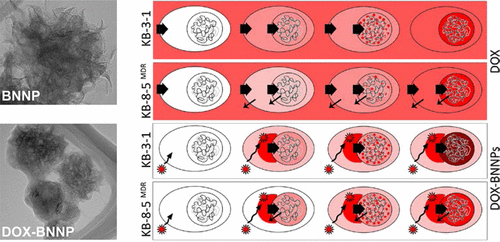当前位置:
X-MOL 学术
›
ACS Appl. Mater. Interfaces
›
论文详情
Our official English website, www.x-mol.net, welcomes your
feedback! (Note: you will need to create a separate account there.)
Effect of BN Nanoparticles Loaded with Doxorubicin on Tumor Cells with Multiple Drug Resistance
ACS Applied Materials & Interfaces ( IF 8.3 ) Pub Date : 2017-09-15 00:00:00 , DOI: 10.1021/acsami.7b08713 Irina Y. Zhitnyak 1 , Igor N. Bychkov 1 , Irina V. Sukhorukova 2 , Andrey M. Kovalskii 2 , Konstantin L. Firestein 2, 3 , Dmitri Golberg 3, 4 , Natalya A. Gloushankova 1 , Dmitry V. Shtansky 2
ACS Applied Materials & Interfaces ( IF 8.3 ) Pub Date : 2017-09-15 00:00:00 , DOI: 10.1021/acsami.7b08713 Irina Y. Zhitnyak 1 , Igor N. Bychkov 1 , Irina V. Sukhorukova 2 , Andrey M. Kovalskii 2 , Konstantin L. Firestein 2, 3 , Dmitri Golberg 3, 4 , Natalya A. Gloushankova 1 , Dmitry V. Shtansky 2
Affiliation

|
Herein we study the effect of doxorubicin-loaded BN nanoparticles (DOX-BNNPs) on cell lines that differ in the multidrug resistance (MDR), namely KB-3-1 and MDR KB-8-5 cervical carcinoma lines, and K562 and MDR i-S9 leukemia lines. We aim at revealing the possible differences in the cytotoxic effect of free DOX and DOX-BNNP nanoconjugates on these types of cells. The spectrophotometric measurements have demonstrated that the maximum amount of DOX in the DOX-BNNPs is obtained after saturation in alkaline solution (pH 8.4), indicating the high efficiency of BNNPs saturation with DOX. DOX release from DOX-BNNPs is a pH-dependent and DOX is more effectively released in acid medium (pH 4.0–5.0). Confocal laser scanning microscopy has shown that the DOX-BNNPs are internalized by neoplastic cells using endocytic pathway and distributed in cell cytoplasm near the nucleus. The cytotoxic studies have demonstrated a higher sensitivity of the leukemia lines to DOX-BNNPs compared with the carcinoma lines: IC50(DOX-BNNPs) is 1.13, 4.68, 0.025, and 0.14 μg/mL for the KB-3-1, MDR KB-8-5, K562, and MDR i-S9 cell lines, respectively. To uncover the mechanism of cytotoxic effect of nanocarriers on MDR cells, DOX distribution in both the nucleus and cytoplasm has been studied. The results indicate that the DOX-BNNP nanoconjugates significantly change the dynamics of DOX accumulation in the nuclei of both KB-3-1 and KB-8-5 cells. Unlike free DOX, the utilization of DOX-BNNPs nanoconjugates allows for maintaining a high and stable level of DOX in the nucleus of MDR KB-8-5 cells.
中文翻译:

载有阿霉素的BN纳米颗粒对多药耐药肿瘤细胞的影响
在这里,我们研究了装载阿霉素的BN纳米颗粒(DOX-BNNPs)对多药耐药性(MDR)不同的细胞系的影响,即KB-3-1和MDR KB-8-5子宫颈癌系以及K562和MDR i-S9白血病细胞系。我们旨在揭示游离DOX和DOX-BNNP纳米缀合物对这些类型细胞的细胞毒性作用的可能差异。分光光度法测量表明,在碱性溶液(pH 8.4)饱和后,获得了DOX-BNNPs中最大的DOX量,表明BNNPs被DOX饱和的效率很高。从DOX-BNNPs释放的DOX是pH依赖性的,而DOX在酸性介质(pH 4.0-5.0)中更有效地释放。共聚焦激光扫描显微镜显示,DOX-BNNPs被内吞途径的肿瘤细胞内化,并分布在细胞核附近的细胞质中。细胞毒性研究表明,与癌细胞系相比,白血病细胞系对DOX-BNNPs的敏感性更高:对于KB-3-1,MDR KB-8-5,K562和MDR i-S9细胞系,50(DOX-BNNPs)分别为1.13、4.68、0.025和0.14μg/ mL。为了揭示纳米载体对MDR细胞的细胞毒性作用的机理,已经研究了DOX在细胞核和细胞质中的分布。结果表明,DOX-BNNP纳米共轭物显着改变了KB-3-1和KB-8-5细胞核中DOX积累的动力学。与自由DOX不同,利用DOX-BNNPs纳米共轭物可在MDR KB-8-5细胞核中维持高水平和稳定的DOX水平。
更新日期:2017-09-15
中文翻译:

载有阿霉素的BN纳米颗粒对多药耐药肿瘤细胞的影响
在这里,我们研究了装载阿霉素的BN纳米颗粒(DOX-BNNPs)对多药耐药性(MDR)不同的细胞系的影响,即KB-3-1和MDR KB-8-5子宫颈癌系以及K562和MDR i-S9白血病细胞系。我们旨在揭示游离DOX和DOX-BNNP纳米缀合物对这些类型细胞的细胞毒性作用的可能差异。分光光度法测量表明,在碱性溶液(pH 8.4)饱和后,获得了DOX-BNNPs中最大的DOX量,表明BNNPs被DOX饱和的效率很高。从DOX-BNNPs释放的DOX是pH依赖性的,而DOX在酸性介质(pH 4.0-5.0)中更有效地释放。共聚焦激光扫描显微镜显示,DOX-BNNPs被内吞途径的肿瘤细胞内化,并分布在细胞核附近的细胞质中。细胞毒性研究表明,与癌细胞系相比,白血病细胞系对DOX-BNNPs的敏感性更高:对于KB-3-1,MDR KB-8-5,K562和MDR i-S9细胞系,50(DOX-BNNPs)分别为1.13、4.68、0.025和0.14μg/ mL。为了揭示纳米载体对MDR细胞的细胞毒性作用的机理,已经研究了DOX在细胞核和细胞质中的分布。结果表明,DOX-BNNP纳米共轭物显着改变了KB-3-1和KB-8-5细胞核中DOX积累的动力学。与自由DOX不同,利用DOX-BNNPs纳米共轭物可在MDR KB-8-5细胞核中维持高水平和稳定的DOX水平。











































 京公网安备 11010802027423号
京公网安备 11010802027423号